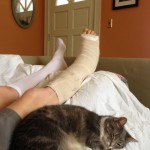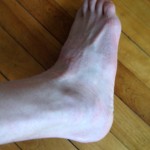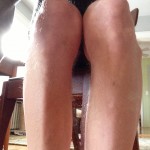Peroneal Surgery #6: Keep Hope Alive
It’s now been a bit more than 10 months since I had surgery to repair my two right peroneal tendons. For those contemplating or recovering from the procedure, I hope that this update will give you some hope.
Overall, things are going well with the foot. I’m back to daily running, and starting to do what almost feels like training. The foot is still very much in my thoughts daily, but I’m largely able to live how I want, with a few exceptions noted below.
During the fall I stayed conservative in returning to running. I didn’t have a seven-day stretch of running every day until October, six months after the surgery. By mid October I had built up my long run so that I was able to complete the Runner’s World Half Marathon in Bethlehem, PA. This was one of the most gratifying experiences I’ve had at a race, even though I wasn’t racing and I ran almost half an hour slower than my half marathon PR.
I’d done a 12-miler, really gently paced, a few weeks before the half. The next two weekends, when I was trying to keep upping my long run, my mechanics got sloppy early on, and I cut the runs short, to something like 10 miles. (Then, and even now, my thinking was/is, my foot can’t afford to bear the brunt of my running poorly. As I was still getting used to running regularly, this happened more often then than now.) So in the half, I just wanted to run comfortably and have it be a positive experience. I started with the 1:45 pace group (8:00/mile), moved up as I felt like doing so, and finished in 1:37:57. It was the most I’d felt like a runner in a year.
My point in droning on about an unremarkable run that’s now four months ago is that it was useful to have that modest-but-slightly-demanding goal (“feel good comfortably finishing the RW Half on October 20”) as I got back into running. Although I wasn’t training, just getting used to running, it helped to have a first benchmark to work toward.
Things kept going well after the half. I was on vacation the second week of the month and felt I could push things a little more than during normal life. I wound up with 65 miles that week, which is still the highest week I’ve had since surgery. At the end of the month, I ran the 4-mile Thanksgiving race in Portland with the goal of breaking 28:00 without too much duress. I wound up running 26:43, and it felt good to do something sustained harder than I’d been running, and for my foot to not bother me doing so.
December was a setback. I discovered after it was too late that snow and ice and the uneven footing they cause are a challenge. I had too many days of taking too many bad steps, and around Christmas time my foot felt as bad as it had a year earlier, pre-surgery. I was really despondent for a few days. I missed a bunch of days of running. But it turned out to be a flare-up, not serious re-injury. I was able to resume progressing in January, and averaged 51 miles a week for the month, a little more than I had in November. After December’s setback, I felt like I was starting from scratch in terms of building my long run. As of last Sunday, the longest I’ve been is 17. My plan is to keep building on that leading up to the Boston Marathon on April 21, where my goal is what it was for the half in October–to be fit enough to enjoy myself running comfortably for the entire distance.
The only other race I’ve been at was a local 10-miler at the beginning of February. I kept with a modest goal–to break 70:00 with as little duress as possible–and was happy to run 69:27 without having to work all that hard. Sustaining faster running is still more of a challenge mechanically than cardiovascularly. I’ve started to do one hard workout a week, such as this morning’s session of 5 x 5:00, but probably won’t do any real racing until after Boston, because I don’t want to introduce another variable that could interfere with that goal.
Again, I hope that someone reading this can see that you should be able to gradually work your way back to close to pre-surgery normality. I still ice my foot after every run. I still do my PT exercises almost daily. And I still limit where I run and walk to minimize the chance of bad steps. (For example, as I write this we’re getting tons of snow, so I assume I’ll be on the treadmill tomorrow). But running feels so much better than it did at this time last year, we’re at mid-February and I’ve missed only one day of running so far this year, and I can reliably plan on running with friends, which is great.
Sorry this is long, and sorry that I’m feeling too lazy to proof it before publishing.
26 comments Digg thisMusic-Related Minimalism Book Giveaway
Here’s the deal: You recommend a band I wind up liking more than anyone else’s recommendation, and I’ll send you a copy of my minimalism book.
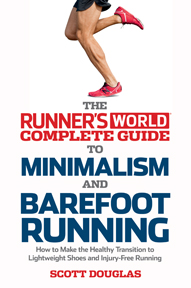 Below are the 25 band or musician names at the top of the most-played list in my iTunes library. On the basis of those, recommend someone else for me to listen to.
Below are the 25 band or musician names at the top of the most-played list in my iTunes library. On the basis of those, recommend someone else for me to listen to.
If I’m already familiar with the band or musician, I’ll let you know, and you can make another recommendation.
I’ll take recommendations through Sunday, June 16, and then decide whose recommendation I like the best, and send that person the book.
Send your recommendations here or leave them in comments below. Here are the musicians to use as the basis for your recommendation:
Vincent Herring
The Feelies
The Liminanas
Whirr
Yuck
Pia Fraus
Wild Nothing
Bears
Eric Reed
Stereolab
The High Violets
Matt Pond PA
Swell
Sparrow
American Analog Set
Black Tambourine
Lush
Metropolitan
God
James Moody
Nord Express
Band of Susans
Luna
Jim Rotondi
Real Estate
Peroneal Surgery #5: How I Got in This Mess
Here’s the back story to why I wound up having peroneal tendon repair surgery.
My right calf, Achilles and ankle have always been more rigid than my left. That became more so after a nasty bout of Achilles tendinitis in 1992. As I’ve noted before, I’ve also long had extra “stuff” below the lateral right ankle. And I sprained the ankle a bunch of times as a kid. So I was a good candidate to overstress the peroneal tendons, in part by placing extra load on them because of rigidity in the foot and ankle leading to not rolling through the running gait as would be ideal.
The first time my foot became troublesome in what would become familiar ways was the summer of 2010. The discomfort and dysfunction was not around the ankle, but along the lateral bottom of the foot, near the cuboid bone. I was worried I had a stress fracture. I think I did a couple bouts of a couple days off, and definitely had reduced mileage. It didn’t go away, but it didn’t continue to deteriorate, and I went about my business. Over the next year and a half I would occasionally have flare-ups, and I’d be concerned I had a stress fracture in my foot. (It’s funny to think now that my reaction was, “Not a stress fracture of the foot! I might have to take off like four weeks!” As I write this, I haven’t run in close to four months.)
During that year and a half, I could generally trace a relationship between more time working (read: sitting with bad posture) and my foot acting up. The more my hips felt out of alignment for days at a time, the more likely it was my foot would start complaining. And during this time the wear on my running shoes, which had always been heavier on my left shoe, became much more that way. (Yes, more wear on the “good” foot, but the one with less wear is the one that was going kaput. There are some recent studies about asymmetrical running gaits and lack of relationship to injury site.)
One morning in February 2012 I stepped out of bed and found I could barely put weight on my right foot. The area around the lateral ankle was acutely tender. I had to walk with my right foot turned way out to get going that morning. I remember being in a good mood while cooking the night before and briefly–very briefly–doing a little dancing to “Gardening at Night” by REM.
Of course I ran that afternoon, but something was different. This wasn’t so much the cuboid-area foot pain of before, although I think that was also present. This was tenderness, tightness and dysfunction in soft tissue around the lateral ankle. Running felt different.
I muleheadedly plugged away for the next few weeks. I remember doing an easy 90 minutes on St. Patrick’s Day and spending the entire run dreading every time my right foot was going to hit the ground. I took some time off, got some massages from my friend Julia Kirtland, and experimented with her Kinesio taping me.
When I resumed running, things waxed and waned. I had at least one more stretch of not running for a few days, which I should note was at the time a big deal.
During this time I began to sleep with my foot on top of a pillow. The ankle was always stiffest in the morning. And I will admit to occasionally hiding from my wife how much limping I often did the first few minutes of the day.
In August 2012, I began to ramp up my mileage for the Philadelphia Marathon on November 18. One of the oddest things of this episode is that those three months were by far the best in terms of the ankle. I was regularly doing 80-mile weeks, with what passes for quality for me these days, and things with the foot and ankle were better, not worse, than before.
At the same time, my lifelong nemesis, my left hamstring attachment, got worse. It was noticeable whenever I did tempo runs or workouts. The shoe wear difference became ridiculously large.
The marathon didn’t go well. I was trying to run 3:05, which was a conservative goal given my fitness. Through 15 I was holding back to stay just over 7:00 pace. In the 16th mile my left hamstring attachment went into vise-grip mode. I immediately had to slow, and knew it would be yet another disappointing end-run at a marathon. I thought about dropping out–at this point I could have turned around and jogged back 3 miles and been at the start/finish area. I envisioned my wife having to explain to people nice enough to care that I’d dropped out. So I talked myself down to 18 miles, by which point turning around and jogging back to the finish would mean 23 miles, which, I told myself, would mean that you should just finish the damn thing.
After a couple more miles my form went to complete crap. I wound up finishing in 3:21, aghastly aware of how horribly I was running in a mechanical sense. I don’t remember my foot and ankle being an issue. It was just an overall biomechanical shutdown stemming from the initial hamstring problem.
After the race I couldn’t walk normally. My quads were tender, and the protective gait I adopted was Frankensteinesque, with really no knee flexion.
So the next day, of course, I tried to run. I Frankensteined my way around the neighborhood for half an hour, which I called 3 miles. I felt a little looser after. The following day I ran thusly for 4 miles, then 5 miles three days after the marathon. After that run, I wrote in my log “foot horrible.”
The foot remained an issue since that run three days after the marathon. My theory is that running with such horrible form for so long in the marathon, then stupidly doing so in the days after, pushed the tendons over the edge. They were obviously severely compromised to begin with, but this was too much for them.
The last good run I had was Sunday, November 25, one week after the marathon. It was one of those runs where you step out the door and are in full relaxed-fast mode within three steps. I got to a spot that usually takes 26 minutes to get to in 24:30. I spent the run thinking how I would quickly recover from the marathon, then build on the fitness I’d built training for it.
The next morning my foot was the worst it’d ever been. I ran 10 minutes. I still ran every day that week, but just a few miles. The following Saturday I ran 9 miles with Julia and some other friends on trails, and was limping and wincing the whole way. I then began a phase of taking off a few days at a time, thinking I could finesse my way through the most acute phases. This continued, with ever-decreasing attempts at running, through the end of January.
I did every foot/ankle exercise I could think of that might improve the area, but was never sure if I was doing more harm than good with these.
On January 29 I was in Emmaus, Pennsylvania for some Runner’s World meetings. I joined a large group for their noontime run. I got dropped immediately, while feeling like I was working as hard as I could mechanically. Nothing against the members of the group, but I told myself, “If you’re getting dropped by them three minutes in, it’s time to admit something is really, really wrong.” I turned around and limped back to the office. That 2-miler is the last time I’ve run.
I then told myself I wouldn’t even try to run until the visible swelling in the ankle and foot went away. The swelling stayed. In late February I had an MRI. The radiologist’s reading said torn peroneus brevis, severe tendonosis in peroneus longus, tenosynivitis in hallor flexus longus, and three areas of increased bone activity indicating precursors to stress fractures.
My friend Brian Fullem, a sport podiatrist who has been amazingly helpful throughout this ordeal, told me he’d be shocked if these problems resolved themselves without surgery. So of course I found an orthopedist who told me otherwise, that immobilization for a few weeks would do the job, and of course I went with his take. But I knew deep down that wasn’t going to work, and I got myself to see another orthopedist, and told myself I would have surgery if he agreed more with Brian than the first orthopedist.
And here we are today, almost six weeks after the second orthopedist operated on me.
6 comments Digg thisPeroneal Tendon Surgery #4: Effects of Inactivity
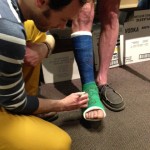 With two more weeks to endure of no weight bearing, here are some things I would like to do:
With two more weeks to endure of no weight bearing, here are some things I would like to do:
Walk.
Have need for toilet paper.
Not be depressed.
Have my hands free.
Be hungry.
Sleep normally.
Comments are off for this post Digg thisPeroneal Tendon Surgery, #3: Excess Work is Welcome
I’m still not up for the long back story to how I got to this point. So here are some random first-week-after-surgery observations that might help others who will go through this.
Assuming you don’t have complications, try to get back as soon as possible to your normal non-exercise routine. I did only token work the two days after surgery, but was back at it Thursday (three days after) and even more so Friday. With the Boston Marathon tomorrow, I’ve been busy with work this weekend, which has been welcome. I’m fortunate to be able to work from home as my default, so doing so with my legs elevated while lying on the sofa isn’t terribly different than usual.
I downloaded a chime app for my iPhone and have it set to go off every hour between 8 a.m. and 9 p.m. This reminds me to put my foot on the ground for a few minutes (as gently as possible, natch, given the orders against bearing weight).
My friends have been great about visiting. I hope I’ve convinced them I’ll be that much more in need two weeks from now. I’ve basically never been idle this long and anticipate being quite emotionally miserable by the end of the month.
That said, so far I’ve had surprisingly few wallowing moments. And those have stemmed more out of frustration of living life on crutches (as in, “Ugh, I left my pillow on the sofa, now I have to go through the laborious process of getting it because I’ve already asked Stacey for too many favors today”) than existential angst about whether this injury and surgery are life changers. (As Bane said in The Dark Knight Rises, “Calm down, doctor. Now’s not the time for fear. That comes later.”)
I had a prescription for 40 oxycondone, but put the bottle away yesterday with maybe 15 left. I don’t have a lot of pain, and figure I’d like to save them for if something happens and I have more use for them. Yesterday also marked the end of the Naproxen and Tylenol, which I hope also means the end of not needing toilet paper. It’s been odd to go from someone who can make two pit stops during a run to someone for whom that’s a week tally.
I haven’t really done anything in terms of activity, and am not yet miserable. Yet. I checked out a friend’s rowing machine yesterday and decided that wasn’t going to work while I have the splint on. So far I’ve done just daily crunches/ab stuff with my legs on the sofa, stretching for my shoulders and neck, and today I crutched around the block (maybe a quarter-mile). A few leg exercises of the Myrtl sort are possible, but not ideal, and I’m still in the period where I’m supposed to keep the leg elevated as much as possible.
I rented a knee scooter for a month. This has been helpful to move around the house when I have fragile or liquid things to transport. I haven’t taken it outside yet, because that would mean exiting the house on crutches, then having it waiting for me at the bottom of the stairs. Maybe next weekend I’ll have Stacey drive me somewhere so that I can scoot around on a quiet road and feel the breeze on my face.
I finally found a use for all those mini-backpacks races and shoe companies hoist on you these days. They’re perfect for toting small items like books and napkins when you’re on crutches.
Sleeping has been a challenge. I slept on the sofa the first four nights. I started in bed Friday and Saturday nights, but eventually made my way to the sofa because I couldn’t get comfortable and didn’t want to wake Stacey doing my ailing-landed-fish routine. Last night was the first time I woke up and found myself sleeping on my right side, which is a no-no, and led to being up for awhile with some significant discomfort.
I’m not yet bored with consciously restricting how much I eat, but I imagine I will be well before I’m active enough to justify eating my normal amount.
1 comment Digg thisPeroneal Tendon Surgery, #2
So, uh, things were worse in there than suspected. Both peroneal tendons were torn. The peroneus brevis was only about 20 percent intact, while the peroneus longus was 40 percent intact. The MRI reading had indicated “only” severe tendonosis in the longus. Whatever. The surgeon repaired them as best able via stitching, and shaved down part of a bone, the peroneal tubercle, that was irritating the tendons.
I’ve had “extra stuff” forever (like 20 years) in the area where I think the peroneal tubercle lives. So I wonder if that bone spur he shaved down was a, if not the, prime instigator for the downward spiral that led to having surgery.
For those interested in learning more about the background of and surgery for this injury, I’ll get to that eventually. I’m still fairly out of it and it’s hard to concentrate on one thing for a long time, so I’ll leave you with a picture of splint and day nurse. I’ll be in the splint for four weeks, with no weight bearing on the right leg during that time.
Comments are off for this post Digg thisPeroneal Tendon Surgery, #1
Later this afternoon I’m going to have surgery to repair my right peroneus brevis tendon. I had hoped to avoid ever being cut open for running-related reasons, but oh well. Once every 34 years and 100,000 miles seems acceptable.
I’ll try to document this experience in the hope that others who might be having similar issues can learn. As with most health-related Internet searches, especially for relatively obscure running injuries, I encountered more confusion than clarity.
Later I’ll describe at length the symptoms, probable causes and concatenation of bad decisions I made that led to having surgery. For now I’ll keep it to a few pre-surgery photos that show some of what’s been going on.
The other day I took photos of my lateral right and left ankles. These are far from the most illustrative images, but you should get the idea. Notice the swelling and general “extra stuff” around the right ankle compared to the left. (Both look a little weirder than usual because I’d just gotten off the bike when I took these.)
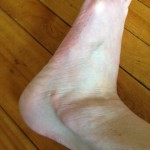 First is the asymptomatic (but hardly beautiful!) left ankle.
First is the asymptomatic (but hardly beautiful!) left ankle.
Here’s the right ankle.
The other at-a-glance noticeable difference is left and right lower leg diameter. Here the right one is smaller, because favoring the damaged tendon for months led to atrophy of the muscles on that side. In this photo the difference is most noticeable toward the top of the lateral lower leg, where the relevant tendons and muscles start. There’s also a significant difference in calf diameter that I wasn’t able to capture using my iPhone.
Hmm, seems I need to start getting ready to leave for surgery. The next post will probably be immediate post-surgery stuff, then I’ll get more into the back story.
2 comments Digg thisExcerpt From My Minimalism Book
Chapter on the future of minimalism.
Because the excerpt doesn’t contain a link to easy purchase of the book, here’s one.
Comments are off for this post Digg this